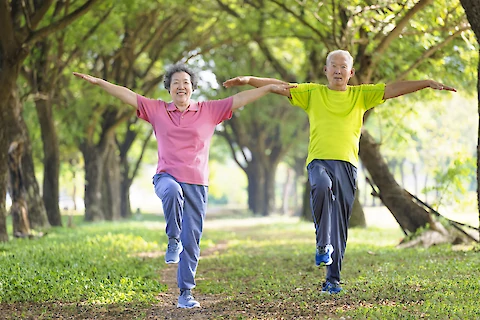
Fall prevention becomes increasingly important as people get older. Certain health conditions and certain medications that are used to treat these conditions can impact balance, coordination, and control. The good news is that retaining balancing skills is often as easy as staying active. With the right stretching and strength-building routines, it's possible for Chicago and Cook County locals to remain agile, active, and safe throughout all stages of life. Following are three easy exercises that help with balance and fall prevention.
1. The Toe Touch
Exercise for fall prevention works because it develops, strengthens, and preserves the muscles that keep people upright. However, some of the most effective activities for ensuring good balance and preventing falls don't build muscles so much as they stretch them. Stretching the legs, lower back, and hips promote better motility in the joints and increased flexibility. This way, if you lose your footing, need to travel up or down stairs, or have to negotiate a littered surface, you're more likely to stay upright.
The toe touch proves that you don't have to pay a fortune for personal training in Cook County, IL to keep your balance strong. It is a simple exercise that can be performed while standing upright or while sitting on the floor with your legs stretched out in front of you. If standing, place your feet a shoulder's width apart and gently bend at the waist. Stretch down until your fingertips touch the tops of your toes or as close as you can get. After holding your position for several seconds, slowly return to a standing position. Move slowly, breathe deeply, and don't force the movement. If you do this exercise every day, you're guaranteed to notice improvements over time.
If sitting, gently bend forward without curving your back. Attempt to drop your chest close to your knees rather than hunching over them. Remember, if you can't touch your toes right away, that's okay. Keep working on it and you'll be able to stretch further in no time.
2. Sit to Stand
The "sit to stand" exercise is like a supported squat. It builds up the leg muscles, improves balance, and encourages focus and control. Find a stable, solid chair and sit down in it with your feet planted firmly on the floor. When you're ready, squeeze your gluteal muscles and use the fronts of your thighs to lift yourself out of the chair. If you need a little help, put your palms on the seat of your chair and use them to push yourself up. When you're fully upright, take a deep breath and gently lower yourself back down. Try doing ten repetitions of this exercise three to four times each week. The "sit to stand" exercise engages nearly all of the muscles in the legs. It also improves body mechanics and balance. You can work your way up to 10 "sit to stand" repetitions, and you should perform this exercise two to three times each week.
3. The Flamingo
If it isn't their bright pink hue, Flamingos are perhaps best known for their tendency to stand on one leg. Practicing balancing on one foot is a great way to build up your balancing skills. For this exercise, stand behind your sofa, a table, or a stable chair with your hands resting lightly on its top. Place your feet a comfortable distance apart and then gradually lift one foot by curling your leg behind you. Try not to put your weight on the table or chair that you're standing in front of. You should only grab onto this support if you absolutely need it. Instead, have someone standing by to assist you. This way, if you ever feel unstable, you'll have a ready, steadying hand.
Try holding this position for 30 seconds. Then, repeat the exercise on the other leg. Strive for 20 repetitions of this activity at least three to four times each week. With benefits that sound almost too good to be true, "The Flamingo", or balancing on one foot, recalibrates the brain, forms new neural connections, and improves the coordination between your muscles, joints, eyes, and ears.
Get Help With Balance and Fall Prevention From Senior Helpers
Remember, before starting this or any other exercise regimen, start by consulting with a healthcare professional. If you need a companion in Chicago or Cook County, IL to help you stay on top of your balance training and fall prevention, companion care from Senior Helpers of Chicago/Evanston is an excellent choice. Senior Helpers offers personal care, transitional care, and more. We're here for older people at every stage of life, and to assist with every challenge and change. To find out more, contact us today!